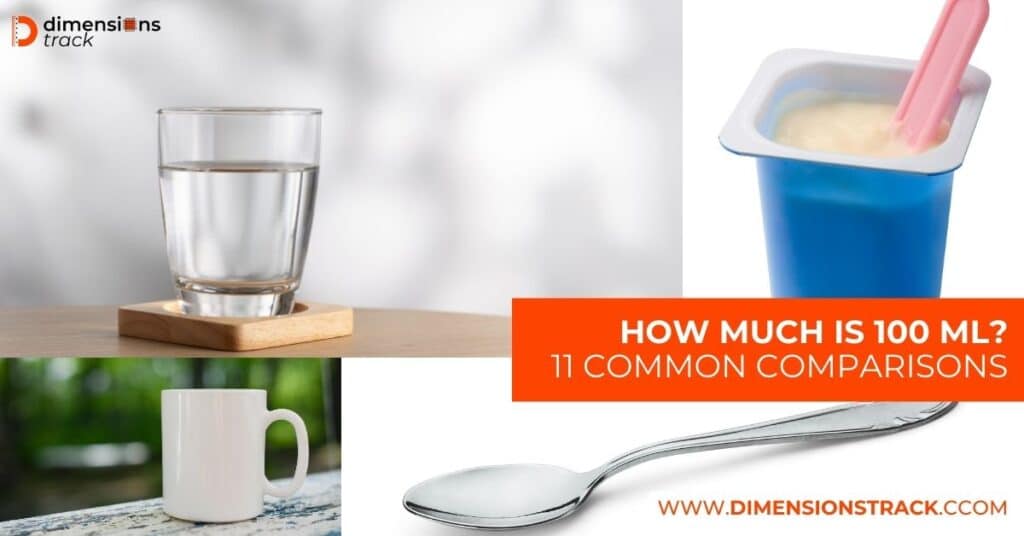Knowing exactly how much 100 ml is can be confusing, especially when you’re in the middle of cooking, pouring a drink, or measuring something for a DIY project. But no need to worry! I’ve compiled a list of common comparisons to help you visualize how much 100 ml actually is, whether you’re using a glass, a bottle, or everyday kitchen items.
How Much is 100 ml of Water in a Glass?
If you’re holding a standard drinking glass, you might be wondering how much 100 ml of water looks like. The average glass holds between 250 ml to 300 ml, so 100 ml would be roughly one-third of the glass. To be precise, filling a glass to about 1.6 inches (4 cm) from the base would give you approximately 100 ml of water.
However, not everyone is carrying around a ruler to measure water height, right? An easier method is using teaspoons. Since a teaspoon holds about 5 ml, 100ml of water would equal 20 teaspoons. That’s right—just scoop out twenty teaspoons, and you’re good to go! If you’re working with tablespoons, keep in mind that 100 ml is roughly equivalent to 6 1/2 tablespoons, since each tablespoon holds 15 ml.
This amount is common in everyday situations like when you’re measuring a small amount of water for a recipe, hydrating plants, or adding water to certain beauty products.
How Much is 100 ml in Grams?
Now, if you’re dealing with grams instead of milliliters, it’s important to note that the weight of 100 ml depends on the liquid you’re measuring. For water, it’s simple—100 ml of water equals 100 grams since the density of water is 1 g/ml. But what about other liquids?
For example, milk is slightly denser than water, so 100ml of milk weighs around 103 grams. Meanwhile, 100 ml of vegetable oil weighs about 92 grams. This is because oil is lighter than water. Honey, on the other hand, is much denser—100 ml of honey weighs approximately 142 grams.
Here’s a handy table to give you an idea:
| Liquid | Weight of 100 ml |
| Water | 100 grams |
| Milk | 103 grams |
| Vegetable Oil | 92 grams |
| Honey | 142 grams |
In the kitchen, knowing these conversions can be a huge help when you’re substituting ingredients or measuring liquids for cooking or baking.
Visualizing 100 ml: Common Comparisons
One of the best ways to understand 100 ml is through comparisons with common objects. Let’s break down 10 relatable comparisons to help you estimate 100ml without any special tools.
Got it! Here’s a more detailed and expanded version for each item to provide a fuller picture:
1. 1/9th of a Quart of Milk

A quart is a familiar size when it comes to dairy products like milk, cream, or even juices. One quart equals 946 ml, which is a bit shy of a full liter. Now imagine dividing that quart into nine equal portions. Each of those portions would be about 100 ml. Although it’s not an exact science, visualizing a quart container like a milk jug can help you estimate.
When you’re pouring 100 ml from a full quart, it’s a small portion but not insignificant. This comparison helps especially when you’re working with large quantities of liquids and need smaller amounts for cooking or other uses. 100 ml is about what you might add to coffee or cereal in the morning, a small but important addition!
2. Two Shot Glasses

If you’re familiar with shot glasses, you already know they’re a great way to visualize small amounts of liquid. A typical shot glass holds between 44 to 50 ml. If you fill two shot glasses, you’re looking at approximately 100 ml. In bars, shot glasses are standard measurements for serving small, strong drinks, but they also come in handy in the kitchen.
When you’re baking or making cocktails, pulling out two shot glasses can be an easy, fuss-free way to measure out 100 ml without needing any additional tools. This comparison also works well for quick estimations in everyday tasks, like measuring liquids for a sauce or a salad dressing.
3. 1/5th of a 500 ml Water Bottle

We’ve all seen those 500 ml water bottles available everywhere, from convenience stores to vending machines. These bottles are convenient for hydration, but they also give a good sense of scale when it comes to measuring smaller amounts of liquid. If you divide the bottle into five equal portions, each portion would be 100 ml.
Pouring 100 ml from a 500 ml bottle looks like a small but noticeable amount. This is especially handy when you’re out and about and need a quick, reliable way to estimate 100 ml—whether you’re using it to water plants, refill a humidifier, or add water to a recipe.
4. 1/10th of a 1-Liter Jug

A 1-liter jug is commonly used for serving beverages like water, juice, or milk at home. 1 liter equals 1000 ml, so 100 ml is exactly one-tenth of a liter jug. Most measuring jugs have clear markings for 100 ml, but even without the markings, estimating 1/10th is fairly straightforward.
If you pour 100 ml from a 1-liter jug, it’s a small pour that doesn’t seem like much at first glance, but it can make a significant difference when following a recipe or filling a container. This comparison is particularly useful when working with larger quantities, helping you measure smaller amounts with confidence.
5. 6 1/2 Tablespoons

In many kitchens, measuring spoons are much more accessible than measuring cups. One tablespoon equals 15 ml, so 100 ml equals about 6 1/2 tablespoons. This measurement is ideal for cooking or baking, especially when a recipe calls for small liquid amounts.
To measure 100 ml, you simply scoop out 6 tablespoons and then half of another one. It’s a quick and easy method that doesn’t require fancy measuring tools. Tablespoons are universally available, and this conversion can be incredibly handy when following a recipe on the fly.
6. A Small Yogurt Container

Next time you’re enjoying a snack, take a look at the size of the small yogurt containers available in stores. Many of these containers hold 100 ml of yogurt, which can help you visualize 100 ml of liquid. These small yogurt containers are perfect for portion control and give a great sense of what 100 ml looks like in a solid or semi-liquid form.
Whether you’re measuring liquids for a beauty product or making smoothies, having a 100 ml yogurt container handy can be a great visual guide. The container itself is small, easy to hold, and precisely the size you need for this comparison.
7. 20 Teaspoons

When you think of teaspoons, they seem tiny—perfect for stirring sugar into your tea or coffee. One teaspoon holds 5 ml, so 100 ml equals 20 teaspoons. This is a great trick for when you need to measure out smaller amounts of liquid but don’t have any other measuring tools handy.
To measure 100 ml, just grab a teaspoon and start counting! While it may seem tedious, knowing that 100 ml equals 20 teaspoons gives you an accessible way to measure when you’re working with smaller containers or trying to estimate in a pinch. This method is especially useful for beauty and health products, like lotions or oils, that often require precise amounts.
8. A 100 ml Medicine Bottle

If you’ve ever had to take liquid medicine, you’re probably familiar with the small bottles they come in. Many of these medicine bottles hold exactly 100 ml, and this can be a helpful point of reference when visualizing 100 ml in other contexts. These bottles are designed to provide accurate doses, so they offer a clear, real-world example of what 100 ml looks like.
Whether you’re measuring water, juice, or oil, picturing a 100 ml medicine bottle can make it easier to estimate the correct amount. These small bottles are common in both health and beauty products, making them a versatile comparison for everyday use.
9. Half a Tea Mug

We all have our favorite tea mugs, which typically hold between 200 to 250 ml of liquid. If you fill your tea mug halfway, you’ve got approximately 100 ml. This is a quick and easy way to measure out 100 ml without needing any special tools.
Filling your mug halfway can help when you’re adding liquid to a recipe, making coffee, or preparing tea. It’s a practical comparison that most people can relate to, offering a simple way to estimate 100 ml in the kitchen or during your daily routine.
10. 1/3rd of a Regular Drinking Glass

A standard drinking glass holds between 250 to 300 ml, depending on its size. If you fill it about one-third of the way, you’re looking at around 100ml. This is a common scenario when pouring beverages like juice, water, or milk into a glass, especially if you’re watching your portions.
For a quick reference, just pour enough liquid to cover about a third of the glass, and you’ll have an approximate 100 ml. This method is particularly useful in kitchens and dining settings where glasses are readily available and measuring cups may not be.
11. A Standard Coffee Creamer Cup

If you’ve ever had coffee at a diner or fast-food place, you’ve likely seen the small, disposable creamer cups they provide. These tiny containers hold about 10 ml of liquid. To visualize 100 ml, you would need 10 of these creamer cups. Though they seem tiny, collectively, they add up to 100ml of liquid.
This comparison can be especially useful when you’re trying to gauge small amounts of liquid in the kitchen or for personal care products. Imagine pouring 10 small creamer cups into a larger container—that’s the volume you’re dealing with when handling 100ml. It’s a fun and practical way to get an accurate sense of 100 ml without needing special measuring tools!
Final Thoughts
Now you’ve got 10 easy ways to visualize 100 ml. From coffee cups to shot glasses, teaspoons to yogurt containers, you’re all set to measure with confidence.
Remember, how much is 100ml might seem tricky at first. But with these everyday comparisons, you’ll be a pro in no time.
Each of these methods has its strengths and is suited for different situations. The key is to find the ones that work best for you and the task at hand.
Whether you’re cooking, mixing drinks, or just curious, understanding 100 ml is surprisingly handy. It’s all about finding what works best for you in different scenarios.
Remember, while these comparisons are great for quick estimates, always use proper measuring tools when precision is crucial, especially in baking or when dealing with medications.
So next time you’re wondering how much is 100ml water or any other liquid, you’ve got plenty of options. Happy measuring!
Fun fact to leave you with: Did you know that 100 ml is also roughly the amount of tears a human can produce in one hour of crying? Let’s hope you won’t need to measure that anytime soon!
Keep exploring, keep measuring, and remember – knowledge is power in the world of volumes. Whether you’re a cooking enthusiast, a mixology master, or just someone who likes to know the little details of everyday life, understanding 100 ml is a skill that will serve you well. Cheers to your newfound volume visualization superpowers!

Henry Martin is a dedicated author at Dimensions Track, specializing in creating informative guides on the dimensions and measurements of various objects. With a passion for providing precise and reliable information, Henry helps readers make well-informed decisions about everyday products and spaces. His attention to detail ensures that each guide is thorough, easy to understand, and packed with useful insights for anyone seeking accurate measurements.







